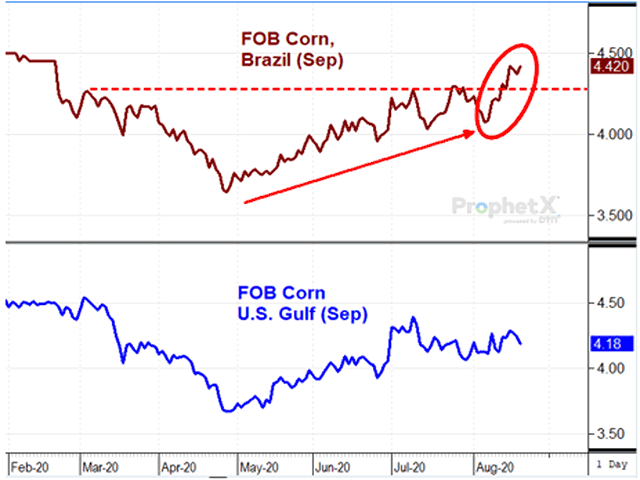Todd's Take
What Is Happening in China?
By now you've heard the bearish mantra of grain market factors for 2020 repeated so often you can recite them in your sleep. Big crop surpluses, coronavirus, trade disputes, tough export competition, good weather -- the list goes on.
In the U.S., 2020 followed the worst planting conditions on record and difficult harvest conditions for many as well. In January, it looked for a moment like the phase-one agreement offered the U.S. some hope of increased export business. The actual details, however, proved disappointing, and when the global pandemic erupted, we had to admit things had indeed gotten worse.
Forgetting our sorry troubles for the moment, look at China. Up to and following the time in January when the phase-one agreement was signed, China remained largely defiant of U.S. demands and withstood whatever economic discomfort the new U.S. tariffs brought.
Early on, China offered to buy more U.S. goods and made promises about doing a better job of protecting private companies' technological secrets. But beyond those diplomatic gestures, it offered little else to ease the layers of tit-for-tat tariffs that quickly built up between the two countries.
Before coronavirus emerged, China weathered the trade storm pretty well. GDP increased at a roughly 6% annual rate and U.S. soybean purchases were kept to a minimum, thanks to belt-tightening and a large Brazilian soybean harvest in 2019 and record harvest in 2020.
In 2018-19, China only imported 493 million bushels (mb) of U.S. soybeans and is on track for a slightly higher amount in the current season that ends on Aug. 31.
P[L1] D[0x0] M[300x250] OOP[F] ADUNIT[] T[]
Compared to the 1.327 billion bushels (bb) of U.S. soybeans China imported in 2016-17, the loss of business has been a tough pill for U.S. soybean producers to swallow.
Adding insult to injury, China's stock market -- the Shanghai Composite Index -- is up 10% in 2020, trading at its highest level in over two years and even more than the 5% gain the S&P 500 shows for 2020. The country where COVID-19 began, as President Donald Trump likes to remind us, appears to be recovering well.
A closer look, however, shows a different picture. Before COVID-19 came along, African swine fever hit China's hog herd, cutting pork production by 21% in 2019. USDA's July report of Livestock and Poultry: World Markets and Trade expects another 15% drop in production in 2020.
China's national average hog price is currently trading near 37.36 yuan/kilogram or $2.45 a pound, not far from the 2019 peak of $2.74 a pound (using 6.92 yuan per dollar and 2.20462 pounds per kilogram).
To help make up for the lack of pork production, USDA expects China to produce 14.85 million metric tons (mmt) of chicken meat in 2020, a 27% increase over the past two years. Chicken is also a user of soybean meal as an important feed ingredient and likely contributed to USDA's latest assessment that China will need to import a record high 99.0 mmt of soybeans in 2020-21.
With the above in mind, consider some of the other pieces of the puzzle we are currently seeing related to China. After a record 4.63 bb harvest earlier this year, Brazil's soybean supplies are so short that FOB prices for October ended at $10.87 Thursday, Aug. 20, near the highest in over a year and 75 cents above comparable prices at the U.S. Gulf.
Brazil is also coming off a corn harvest that is expected to match last year's record high 3.98 bb. Yet, FOB corn prices for Brazil in September are at $4.42 a bushel, near the highest of the past six months and 24 cents a bushel above comparable prices at the U.S. Gulf.
Here in the U.S., China purchased 225 mb of new-crop corn and 438 mb of new-crop soybeans as of Aug. 13, a larger early start than usual. More purchases may be hiding under the unknown category.
We could make a lot of guesses as to why China is in such a hurry to buy U.S. corn and soybeans, and perhaps some effort to reach toward phase-one purchase targets is a possibility. But I'm going to venture out and say that I don't think China would be making such aggressive purchases if it didn't legitimately need the goods. The fact China is ignoring multiple criticisms and political disagreements with the U.S. government and buying U.S. goods anyway says something about how much those purchases are needed.
As mentioned above, China's hog prices remain near record highs. January corn on the Dalian exchange is going for 2,305 yuan per metric ton or $8.46 a bushel. January soybeans are priced at 4,499 yuan per metric ton or $17.69 a bushel.
At this point, it is difficult to say just how much potential is in China's current buying spree. But until more is known about South America's harvests early in 2021, the U.S. is the main source of corn and soybeans for large-scale buyers.
Right now, USDA's new-crop corn export estimate of 2.225 bb and new-crop soybean export estimate of 2.125 bb look sufficiently large and overly optimistic. But if China is truly as desperate for food as many of the market clues mentioned above suggest, keep an eraser handy.
Todd Hultman can be reached at Todd.Hultman@dtn.com
Follow him on Twitter @ToddHultman
(c) Copyright 2020 DTN, LLC. All rights reserved.




